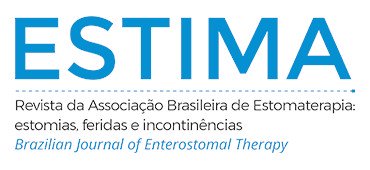Point prevalence of incontinence-associated dermatitis and associated factors in critical patients
Abstract
Objective: To identify the prevalence of incontinence-associated dermatitis (IAD) and its associated factors in critically ill patients. Method: A cross-sectional, quantitative study conducted in the Intensive Care Unit of a private hospital in São Paulo, involving 93 patients who met the eligibility criteria. Data collection took place on a single day in December 2016, with a thorough review of medical records and assessments of hospitalized patients. A three-part instrument was used: 1) sociodemographic data, 2) urinary and fecal elimination, and 3) characterization of IAD. The analysis was performed using descriptive and inferential statistics. Results: Of the 93 patients, 50.5% were women, aged 19 to 104 years. IAD was identified in 40.9% of patients, with a higher prevalence in the intensive care unit (66.7%). Erythema was the most common manifestation (89.4%), and the perianal region was the most affected area (76.3%). The use of antibiotics (p=0.004), corticosteroids (p=0.001), mechanical restraint (p=0.006), fecal incontinence (p<0.001), and urinary incontinence (p=0.026) were significantly associated with IAD. Conclusion: The high prevalence of IAD observed in this study underscores the importance of continuous education and the implementation of evidence-based protocols for managing critically ill patients.
Downloads
Metrics
References
Barakat-Johnson M, Basjarahil S, Campbell J, Cunich M, Disher G, Geering S, Ko N, Lai M, Leahy C, Leong T, McClure E, O'Grady M, Walsh J, White K, Coyer F. Implementing best available evidence into practice for incontinence-associated dermatitis in Australia: a multisite multimethod study protocol. J Tissue Viability. 2021 Feb;30(1):67-77. https://doi.org/10.1016/j.jtv.2020.10.002
Raepsaet C, Fourie A, Van Hecke A, Verhaeghe S, Beeckman D. Management of incontinence-associated dermatitis: a systematic review of monetary data. Int Wound J. 2021 Feb;18(1):79-94. https://doi.org/10.1111/iwj.13496
Sharma P, Latha S, Sharma RK. Development of a need-based interventional skin care protocol on incontinence-associated dermatitis among critically ill patients. Indian J Crit Care Med. 2021 Feb; 25(2):158-65. https://doi.org/10.5005/jp-journals-10071-23716
Kayser SA, Koloms K, Murray A, Khawar W, Gray M. Incontinence and incontinence-associated dermatitis in acute care: a retrospective analysis of total cost of care and patient outcomes from the premier healthcare database. J Wound Ostomy Continence Nurs. 2021 Nov-Dec;48(6):545-52. https://doi.org/10.1097/WON.0000000000000818
Kayser SA, Phipps L, VanGilder CA, Lachenbruch C. Examining prevalence and risk factors of incontinence-associated dermatitis using the international pressure ulcer prevalence survey. J Wound Ostomy Continence Nurs. 2019 Jul/Aug;46(4):285-90. https://doi.org/10.1097/WON.0000000000000548
Grden CRB, Martins AR, Cabral LPA, Reche PM, Arcaro G, Brasil D, Bordin D. Incontinence associated dermatitis in elderly people admitted to a university hospital. Rev Bras Enferm. 2020;73(Suppl 3):e20190374. https://doi.org/10.1590/0034-7167-2019-0374
Ferreira M, Abbade L, Bocchi SCM, Miot HA, Villas Boas P, Guimaraes HQCP. Incontinence-associated dermatitis in elderly patients: prevalence and risk factors. Rev Bras Enferm. 2020;73(Suppl 3):e20180475. https://doi.org/10.1590/0034-7167-2018-0475
Barakat-Johnson M, Stephenson J, Basjarahil S, Campbell J, Cunich M, Disher G, Geering S, Ko N, Lai M, Leahy C, Leong C, McClure E, O’Grady M, Walsh J, White K, Coyer F. Clinician knowledge of incontinence-associated dermatitis: a multisite survey of healthcare professionals in acute and subacute settings. J Wound Ostomy Continence Nurs. 2022 Mar-Apr;49(2):159-67. https://doi.org/10.1097/WON.0000000000000846
Johansen E, Lind R, Sjøbø B, Petosic A. Moisture associated skin damage (MASD) in intensive care patients: a Norwegian point-prevalence study. Intensive Crit Care Nurs. 2020;60:102889. https://doi.org/10.1016/j.iccn.2020.102889
Kaçmaz HY, Kaplan Ö, Kaplan A, Şahin MG, Cetinkaya A, Avci A. Incontinence-associated dermatitis: prevalence in intensive care units and knowledge, attitudes, and practices of nurses. J Nurs Care Qual. 2023 Oct-Dec;38(4):354-60. https://doi.org/10.1097/NCQ.0000000000000707
Campbell J, Cook JL, Doubrovsky A, Vann A, McNamara G, Coyer F. Exploring incontinence-associated dermatitis in a single center intensive care unit: a longitudinal point prevalence survey. J Wound Ostomy Continence Nurs. 2019 Sep/Oct;46(5):401-7. https://doi.org/10.1097/WON.0000000000000571
Gomes ECS. Conceitos e ferramentas da epidemiologia. Recife: Ed. Universitária da UFPE; 2015.
Beeckman D, Van den Bussche K, Alves P, Beele H, Ciprandi G, Coyer F, de Groot T, De Meyer D, Dunk AM, Fourie A, García-Molina P, Gray M, Iblasi A, Jelnes R, Johansen E, Karadağ A, LeBlanc K, Kis Dadara Z, Long MA, Meaume S, Pokorna A, Romanelli M, Ruppert S, Schoonhoven L, Smet S, Smith C, Steininger A, Stockmayr M, Van Damme N, Voegeli D, Van Hecke A, Verhaeghe S, Woo K, Kottner J. The Ghent Global IAD Categorisation Tool (GLOBIAD). Skin Integrity Research Group - Ghent University; 2017.
Bliss DZ, Savik K, Thorson MAL, Ehman SJ, Lebak K, Beilman G. Incontinence-associated dermatitis in critically ill adults: time to development, severity, and risk factors. J Wound Ostomy Continence Nurs. 2011 Jul-Aug;38(4):433-45. https://doi.org/10.1097/WON.0b013e318220b703
Junkin J, Selekof JL. Prevalence of incontinence and associated skin injury in the acute care inpatient. J Wound Ostomy Continence Nurs. 2007 May-Jun;34(3):260-9. https://doi.org/10.1097/01.WON.0000270820.91694.1f
DuPont HL. Guidelines on acute infectious diarrhea in adults. The Practice Parameters Committee of the American College of Gastroenterology. Am J Gastroenterol. 1997 Nov;92(11):1962-75. PMID: 9362174.
Vianna PC, Rabeh SAN, Coelho JN, Riberto M, Castro FFS, Teodoro ML. Core set da Classificação Internacional da Funcionalidade para lesão medular: construção e validação de instrumento. Acta Fisiatr. 2019;26(1):19-24. https://doi.org/10.11606/issn.2317-0190.v26i1a163012
Nix D, Haugen V. Prevention and management of incontinence-associated dermatitis. Drugs Aging. 2010 Jun;27(6):491-6. https://doi.org/10.2165/11315950-000000000-00000
Ferreira M, Abbade L, Bocchi SCM, Miot HA, Villas Boas P, Guimaraes HQCP. Incontinence-associated dermatitis in elderly patients: prevalence and risk factors. Rev Bras Enferm. 2020;73(Suppl 3):e20180475. https://doi.org/10.1590/0034-7167-2018-0475
International Guidelines. Pressure ulcer prevention: prevalence and incidence in context. A consensus document. London: MEP; 2009.
Bernardes RM. Prevalência de úlcera por pressão em um hospital de emergência e características dos pacientes [dissertação]. Ribeirão Preto: Universidade de São Paulo, Escola de Enfermagem de Ribeirão Preto; 2015. https://doi.org/10.11606/D.22.2016.tde-23122015-103420
Wang X, Zhang Y, Zhang X, Zhao X, Xian H. Incidence and risk factors of incontinence-associated dermatitis among patients in the intensive care unit. J Clin Nurs. 2018 Nov;27(21-22):4150-7. https://doi.org/10.1111/jocn.14594
Banharak S, Panpanit L, Subindee S, Narongsanoi P, Sanun-Aur P, Kulwong W, Songtin P, Khemphimai W. Prevention and care for incontinence-associated dermatitis among older adults: a systematic review. J Multidiscip Healthc. 2021 Oct;14:2983-3004. https://doi.org/10.2147/JMDH.S329672
Campbell JL, Coyer FM, Osborne SR. Incontinence-associated dermatitis: a cross-sectional prevalence study in the Australian acute care hospital setting. Int Wound J. 2016 Jun;13(3):403-11. https://doi.org/10.1111/iwj.12322
Domingues BW, Souza TMP, Wojastyk LDMC, Santos VLCG, Nogueira PC. Dermatite associada à incontinência: prevalência e fatores associados em unidade de terapia intensiva. ESTIMA, Braz J Enterostomal Ther. 2022;20:e2822. https://doi.org/10.30886/estima.v20.1281_PT
Monteiro DS, Borges EL, Spira JAO, Garcia TF, Matos SS. Incidência de lesões de pele, risco e características clínicas de pacientes críticos. Texto Contexto Enfermagem. 2021;30:e20200125. https://doi.org/10.1590/1980-265X-TCE-2020-0125
Coyer F, Campbell J. Incontinence-associated dermatitis in the critically ill patient: an intensive care perspective. Nurs Crit Care. 2018 Jul;23(4):198-206. https://doi.org/10.1111/nicc.12331
Arco HMSLR, Costa AM, Gomes BM, Anacleto NMRA, Silva RAJ, Fonseca SCP. Intervenções de enfermagem na dermatite associada à incontinência-revisão integrativa da literatura. Enfermeria Global. 2018;52(3):703-16. https://doi.org/10.6018/eglobal.17.4.319491
Van Damme N, Clays E, Verhaeghe S, Van Hecke A, Beeckman D. Independent risk factors for the development of incontinence-associated dermatitis (category 2) in critically ill patients with fecal incontinence: a cross-sectional observational study in 48 ICU units. Int J Nurs Stud. 2018 May;81:30-9. https://doi.org/10.1016/j.ijnurstu.2018.01.014
Cho JH, Choi JY, Kim NH, Lim Y, Ohn JH, Kim ES, Ryu J, Kim J, Kim Y, Kim SW, Kim K. A smart diaper system using bluetooth and smartphones to automatically detect urination and volume of voiding: prospective observational pilot study in an acute care hospital. J Med Internet Res. 2021 Jul;23(7):e29979. https://doi.org/10.2196/29979
Chianca TCM, Gonçales PC, Salgado PO, Machado BO, Amorim GL, Alcoforado CLGC. Dermatite associada à incontinência: estudo de coorte em pacientes críticos. Rev Gaúcha Enferm. 2016;37(esp):e68075. https://doi.org/10.1590/1983-1447.2016.esp.68075
Downloads
Published
How to Cite
Issue
Section
License
Copyright (c) 2024 Amanda Cristina Maria Aparecida Gonçalves Brandão, Maria Girlane Sousa Albuquerque Brandão, Sandra Christina Pereira Lima Shiramizo, Ramon Antônio Oliveira, Soraia Assad Nasbine Rabeh

This work is licensed under a Creative Commons Attribution 4.0 International License.

























